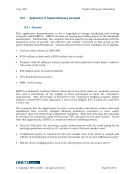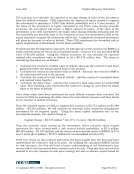June 2007 Capital Adequacy Extension © Copyright 2007, CCRO. All rights reserved. Page 14 of 92 o There are situations where a company has sufficient Financial Liquidity on hand to service short term obligations however, they are not sufficiently capitalized with enough Equity to continue as a going concern. This may be due to increasing risk capital requirements in the mid to long term, thereby eliminating any Economic Value. o Conversely, a company may remain adequately capitalized with sufficient Equity to meet their risk capital requirements however, they may have insufficient liquid assets and may run into problems servicing short term obligations. In this situation a company may have to convert some of its equity into liquid assets in order to service these obligations, thereby reducing the equity available for risk capital requirements. These examples highlight the concept of balancing liquidity requirements and economic capital requirements. The above explanation does not imply that the only difference is the time frame, but rather emphasizes the difference between paying bills (Liquidity Adequacy) and maintaining sufficient equity in your business to remain a going concern (Economic Capital Adequacy). The risks that affect both elements are the same however, the impact of each is different. It is vital to analyze the impact of risks on from both a liquidity and equity perspective. 2.1. Capital Adequacy and Credit Ratings Like the financial liquidity component, the determination of capital adequacy for economic value is a supplemental measure used by credit rating agencies to assess a company’s financial health and overall credit rating. The fact that credit rating agencies incorporate a capital adequacy assessment into their ratings determination is yet another reason why the measure continues to be a focal point for discussion and clarification of calculation methodologies. As with financial liquidity, the concepts and general components of the measure are straightforward but determining the value of the components themselves can be challenging. Although credit rating agency methodologies for assessing a company’s capital adequacy was a key catalyst leading to the CCRO membership’s decision to expand upon the previous capital adequacy white paper, this paper does not specifically address the capital adequacy methodologies utilized by credit rating agencies. Credit rating agencies are faced with the difficult task of applying consistent assessment methodologies to companies within the same industry but with differing business structures. Consequently, solely applying a “one- size-fits-all” measure is nearly impossible for volatility and uncertainty based measures like capital adequacy. To address the credit ratings agencies need for a consistent measurement approach, we have taken the general components and detailed best practices for determining the value of the components while recognizing that each company’s business structure is different and that they are managing their capital to
Purchased by unknown, nofirst nolast From: CCRO Library (library.ccro.org)




























































































